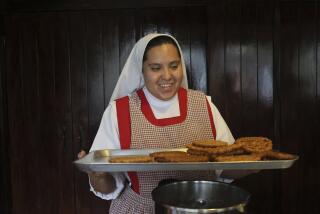Time Out to Honor the Virgin
- Share via
Scores of Latino garment workers, who spend their days putting sequins on $1,500 evening gowns, stood in the company cafeteria Tuesday morning and wiped tears from their eyes as they sang mananitas, songs they’d known since childhood about the Virgin of Guadalupe.
They had arrived at the makeshift Catholic chapel at St. John Knits in Irvine two hours before their 7 a.m. shift to celebrate the feast of Our Lady of Guadalupe.
“For Latinos, especially Mexicans, the holiday is like the Fourth of July and Christmas rolled into a single day. It’s both a national and religious celebration,” said Father Rafael Luevano, who presided over the early morning Mass at the designer clothing company in Irvine. “They’re crying because they love the Virgin. And they also get homesick.”
The celebration of Our Lady of Guadalupe at St. John--which drew more than 400 employees--is a high-profile example of a changing corporate landscape that increasingly allows for spirituality within the workplace.
“In trying to build community within the company, a lot of executives have been allowing religious services of various denominations,” said David Logan, a professor at the USC Marshall School of Business and expert on cultural change within companies.
Logan points to Southern California companies that have reserved rooms where Muslims say their Friday prayers at lunch and Christians sing hymns before work.
More than a decade ago, garment worker Maria Guadalupe Femat asked St. John executives to allow the annual service as long as employees held it during nonworking hours.
“This is a very, very important day at work,” Femat said. “Today, we have one heart.”
The early shift meant that employees could not attend regular church services before work. And the staff also had formed close ties and hoped to celebrate together.
The company agreed.
The feast commemorates the day in 1531 when, believers say, a dark-skinned Virgin Mary--speaking in Nahuatl, the Aztec language--appeared to a poor Indian named Juan Diego in what’s now Mexico City and left her image on his cloak. The original image lies inside the Basilica of Our Lady of Guadalupe in Mexico City.
While the company allows the use of its space, the celebration itself is planned and put on by the employees. For Tuesday’s service, St. John workers within various departments pitched in to buy huge bouquets of roses to decorate the temporary altar, which was surrounded by seven framed pictures of the Virgin. Red, green and white ribbons--the colors of Mexico--were draped across the cafeteria. And many employees brought their sleepy-eyed children, many of whom were dressed in festive costumes.
“It’s very important to them spiritually,” said Rick Richards, vice president of manufacturing in charge of 1,400 workers. “Employees are pretty much what makes this company--it’s a labor-intensive business.”
The trend of spirituality in the workplace, Logan said, is fueled by Generation X employees, who believe companies hire them as more than 9-to-5 workers.
“What the employee is saying is: ‘I’m a complete person, and the company must recognize that I’m a complete person,’ ” Logan said. “Religion obviously is something that executives both don’t want to put the kibosh on and are also concerned that they will alienate people not of that faith.”
Companies that maintain an official religious neutrality, while allowing employees to express their faith, have had few problems, Logan said.
At the St. John factory, Richards said the company has never had a complaint about the service. Many workers described it as the best work day of the year.
On Tuesday, a 10-piece mariachi band led workers in song for 45 minutes before Luevano conducted a service in Spanish.
In his short homily, he joked that while Mexico’s new president, Vicente Fox, is a bachelor, everyone knows the country does have a first lady.
“La Virgen de Guadalupe!” he shouted. The crowd, the majority immigrants from Mexico, roared its approval.
The priest went on to talk about the power of the Virgin of Guadalupe, named last year as the patron saint of the Americas by Pope John Paul II.
As a youth, Luevano recalled, the traditional Anglo representation of the Virgin Mary didn’t move him like the woman with Indian eyes and dark skin.
“I had an intuitive and instinctual attraction to her,” Luevano said. “I had a sense of pride that she was family.”
More to Read
Sign up for Essential California
The most important California stories and recommendations in your inbox every morning.
You may occasionally receive promotional content from the Los Angeles Times.













